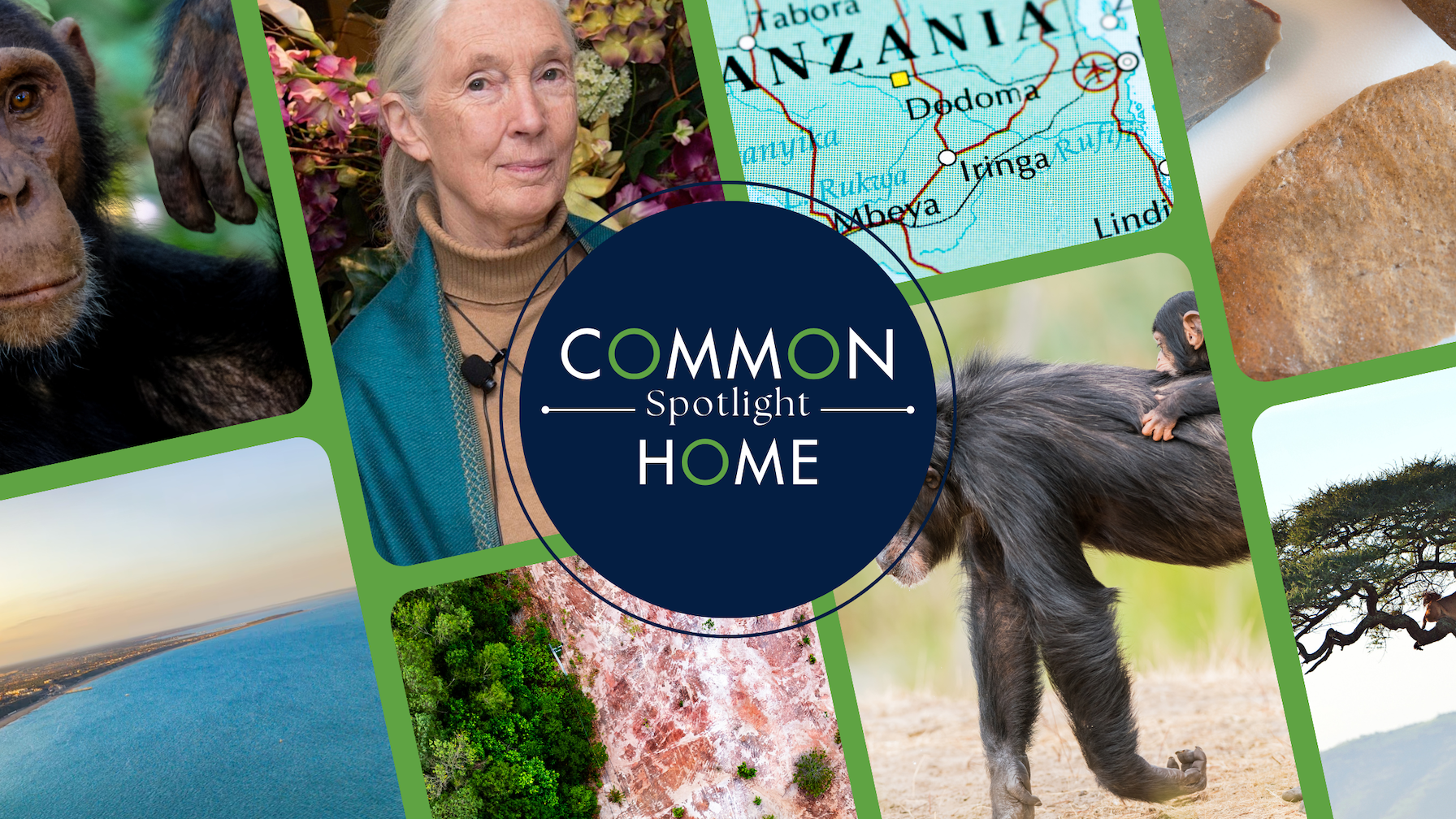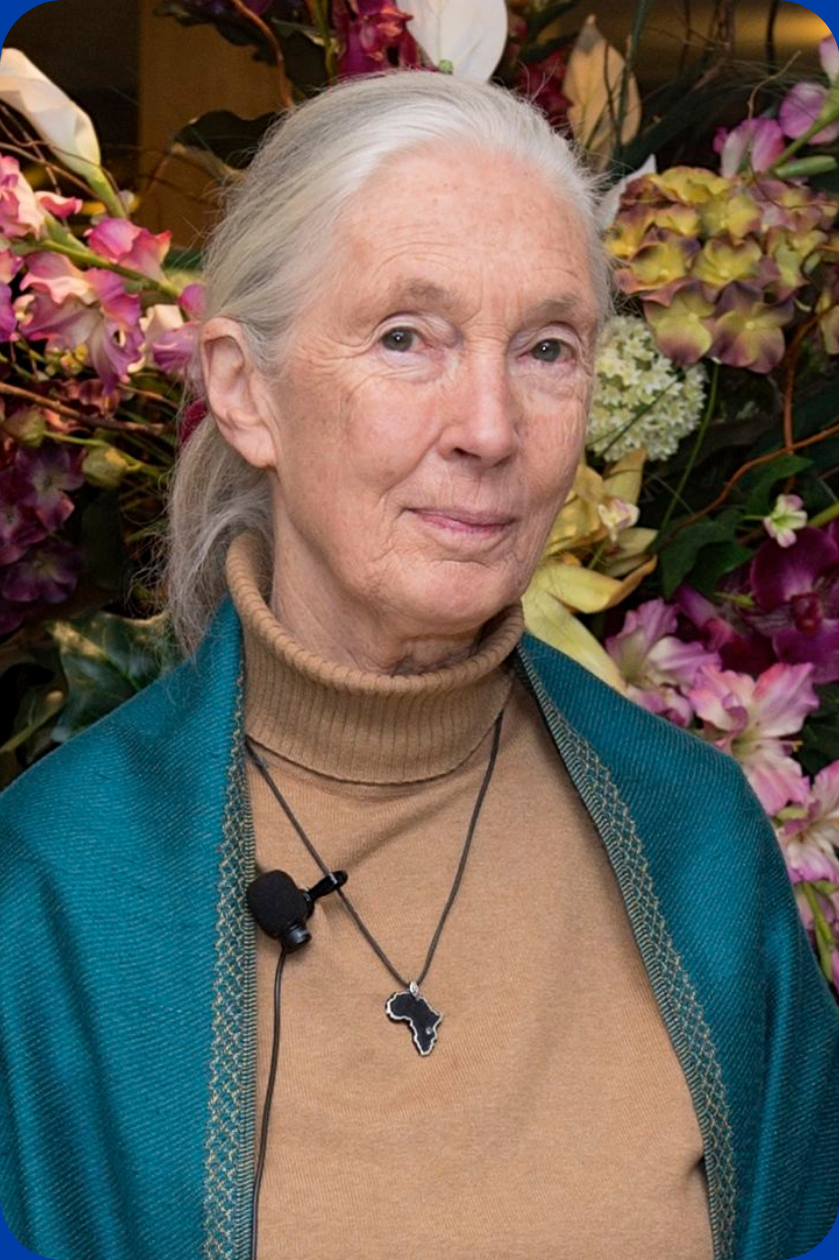“My observations at Gombe challenged human uniqueness. And whenever that happens there is always a violent scientific and theological uproar.”
The Scientific Legacy of Dr. Jane Goodall
A Common Home Spotlight by ECo Faculty Network member Dr. Marisa O. Ensor
October 10, 2025
World-renowned primatologist Dr. Jane Goodall, DBE passed away from natural causes on October 1, 2025. Born in London, England, she was in Los Angeles, CA as part of a speaking tour. Up until the very end of her long life – she was 91 at the time of her death – Dr. Goodall maintained a schedule of nearly constant travel, spending as many as 300 days a year speaking globally to advocate for community-led conservation, empowering young people through her Roots & Shoots program, fundraisingfor the Jane Goodall Institute, and sharing her message of hope as a United Nations Messenger of Peace. I had the privilege of meeting her personally and greatly admire her passion and her indefatigable commitment to these causes that are also dear to my heart. In this post, I have chosen to spotlight a dimension of Dr. Goodall’s legacy less often discussed in popular media: her groundbreaking contributions to anthropological science and field methodology more broadly.
In the Beginning
Affectionately known as Dr. Jane, Valerie Jane Morris-Goodall was born in London on April 3, 1934. When World War II started, she moved with her mother and sister to Bournemouth, a seaside town on the south coast of England which remained her home base throughout her life. Jane’s fascination with animal behavior began in early childhood and was encouraged by her mother. Jane often spoke of hours spent watching native birds and other local animals, and of her habit of making sketches and detailed notes of her observations. Unable to afford college, she instead elected to attend secretarial school in South Kensington. She went on to find employment as a secretary at Oxford University, also working at a London-based documentary film company to finance a long-anticipated trip to Africa. Her life-long dream finally came to fruition in March 1957 when, at the age of 23, Jane eagerly accepted a schoolmate’s invitation to visit their family farm outside Nairobi, Kenya.
In Nairobi she met celebrated paleoanthropologist Dr. Louis Leakey, who hired her as his personal secretary at the local natural history museum. Known for his pioneering research into human evolution at Olduvai Gorge in Tanzania, Louis and his wife Mary – an accomplished scientist in her own right – made numerous discoveries that greatly expanded the human fossil record, including that of our early ancestors Homo habilis, Homo erectus, and their Acheulean tools. The Leakeys’ research shed light on the anatomical and behavioral traits of the world’s first hominids (the family Hominidae includes extinct early human ancestors, modern humans, and extant great apes), providing a new understanding of human evolution in and out of Africa.
Through their groundbreaking findings, the Leakeys concluded that understanding how our ancient ancestors lived required learning more about the behavior of our closest living great ape relatives – chimpanzees, gorillas, and orangutans. In a predominantly male-dominated field, Louis Leakey also thought that a woman would be more patient and insightful than a male observer. This belief was a significant factor in his decision to select three women – Jane Goodall, Dian Fossey, and Birutė Galdikas, affectionally known as “the Trimates” – to conduct pioneering studies on great apes – chimpanzees, gorillas, and orangutans, respectively – in their natural habitats. These three founding mothers of primatology helped unlock key insights about our great ape relatives and about ourselves.
Becoming Jane, the Scientist
Jane Goodall’s area of specialization is called ethology, the scientific study of animal behavior. This field began in the early 20th century with the pioneering work of Ivan Pavlov, Konrad Lorenz, John B. Watson, and B.F. Skinner. Early ethologists mainly conducted experiments and observational studies of animals in captivity. “In those days, work in the natural habitat was frowned upon as unscientific: Only laboratory approaches provided the controls required for conclusive science,” wrote Dutch-American primatologist Frans de Waal in an article published in Nature (2005) on the early years of chimpanzee research.
Louis Leakey was interested in documented the lifestyles and behavior of primates – our closest extant relatives – in their native environment and natural social context. As an anthropologist, he was familiar with the participant observation method developed by Bronislaw Malinowski during his fieldwork in the Trobriand Islands starting in 1914. This approach revolutionized the discipline by moving research from academic desks to immersive, long-term fieldwork, emphasizing the importance of understanding cultures from an insider’s – or emic – perspective. Leakey wanted someone with an open mind unbiased by pre-conceived notions – an approach modern researchers would call grounded theory – something he believed most animal behaviorists of his time lost over the course of their formal training. Unable to find someone suitable, he considered embarking on this task himself. Then, he met Jane Goodall who, when she began her observations of chimpanzee behavior in Tanzania in 1960, did not have an undergraduate degree, let alone a doctorate.
Goodall spoke of animals as having emotions and cultures, and in the case of chimpanzees, living in communities that she described as being almost tribal. She also named the chimps she observed – an unheard-of practice at the time which garnered ridicule from scientists who had traditionally numbered their research subjects to promote scientific detachment. Six months into her study of the chimpanzees of Gombe, Tanzania, she detailed her observations of chimps making and using tools, upending the study of animal behavior. Louis Leakey famously wrote in response, “Now we must redefine tool, redefine Man, or accept chimpanzees as human.”
Jane Goodall earned her PhD in Ethology from Cambridge University in 1965, one of a small group of individuals admitted to the graduate program without holding a bachelor’s degree. Her discoveries revolutionized science by establishing that chimpanzees create and use tools, hunt and eat meat, have individual personalities, and engage in complex social lives including cooperation, deception, political maneuvering, and warfare, thereby challenging fundamental distinctions between humans and other animals. “My observations at Gombe challenged human uniqueness,” Goodall later wrote in her memoir Reason For Hope (2000). “And whenever that happens there is always a violent scientific and theological uproar.”
From Science to Activism
What had begun as a six-month expedition turned into a quarter of a century-long career documenting chimpanzee behavior in the wild. Then, in 1986, came a turning point. At a primatology conference on “Understanding Chimpanzees” in Chicago, Goodall was confronted with the scale of deforestation across Africa, the plummeting numbers of chimpanzees, and the cruelty of laboratory experiments. Goodall resolved to protect chimpanzees but soon realized that many other species faced similar threats. This shifted her focus from detached, albeit unorthodox, scientific observation to a wider, more holistic animal-human conservation approach. “I went to the conference as a scientist,” she later remarked, “and I left as an activist.”
Over more than six decades of groundbreaking research and advocacy, Jane Goodall not only illuminated the critical urgency of protecting chimpanzees from extinction but also advanced a broader understanding of the moral and ecological imperative to safeguard all living beings and the planet that sustains them. She wrote more than 30 books, from the scientific The Chimpanzees of Gombe: Patterns of Behavior (1986) to children’s tales and spiritual reflections like Reason for Hope: A Spiritual Journey (2000), and The Book of Hope: A Survival Guide For Trying Times (2021). She featured in numerous documentaries, including the Academy Award–nominated film Jane, and was celebrated in a highly successful traveling exhibition of her life’s work launched by National Geographic in 2019, called Becoming Jane, which is still open in some museums.
Jane Goodall’s trailblazing path for other women primatologists is arguably her greatest legacy. During the last third of the twentieth century, Dian Fossey, Birute Galdikas, Cheryl Knott, Penny Patterson and many more women have followed her. Indeed, women now dominate long-term primate behavioral studies worldwide.”
Gilbert Grosvenor, former Chairman of the National Geographic Society
Dr. Jane Goodall dedicated her final weeks to the pursuits that defined her life’s work – championing environmental stewardship, fostering human connection across diverse communities, and embodying an enduring message of hope. Her discoveries as an ethologist revolutionized our understanding of what it means to be human and have left an indelible mark on the scientific and conservation fields, inspiring future generations to continue her mission. In the words of Gilbert Grosvenor, former Chairman of the National Geographic Society: “Jane Goodall’s trailblazing path for other women primatologists is arguably her greatest legacy. During the last third of the twentieth century, Dian Fossey, Birute Galdikas, Cheryl Knott, Penny Patterson and many more women have followed her. Indeed, women now dominate long-term primate behavioral studies worldwide.”





